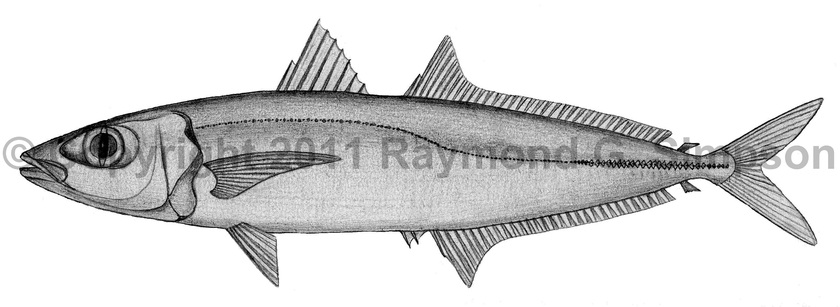
Common Name
Mackerel Scad
Year Described
Cuvier & Valenciennes, 1833
Identification
Dorsal Fin: 8 spines, followed by I, 31-37 (last ray as detached finlet)
Anal Fin: 2 spines, followed by I, 27-31 (last ray as detached finlet)
Pelvic Fin: I, 5
Gill Rakers: 9-13 upper, 31-39 lower
Vertebrae: 10 precaudal, 14 caudal
Elongate and ovoid, with a large head and moderate eye (3.8-4.9 times in HL). Snout longer than orbit diameter. Adipose eyelid well developed, covering entire eye except for a small slit over pupil. Jaw extends to anterior margin of eye. End of upper jaw straight above, rounded below with a slanted posterior edge. Teeth minute; in a single row in both jaws. Upper operculum margin with minute serrations. Shoulder girdle with two small papillae, with two shallow grooves above and below them. Pectoral fins shorter than head. Spiny dorsal fin equal in height to the anterior lobe of the second dorsal. Anterior lobe of anal fin also raised. Tail small and deeply forked. Dorsal accessory lateral line extends only to back of head. Main lateral line with curved anterior portion (with 68-79 scales and 0 scutes) extending back to the middle of the soft dorsal fin base (but shorter than in D. tabl). The straight posterior portion with 19-33 scales and 23-32 scutes. Total scales/scutes 119-133.
Color
Silvery to whitish sides and belly, grading to blue-green or bluish above. Dark spot on upper opercular margin. No spots along curved portion of lateral line. Fins, except caudal, are clear. Caudal fin greenish to yellowish. Symphysis of upper jaw white.
Size
Common to 25cm FL. Maximum size to 30cm FL.
Habitat
Pelagic from the surface to 200m. Forms large schools.
Range
Nova Scotia to NE Brazil, including Bermuda and the Caribbean Sea. Rare in the Gulf of Mexico.
References
Smith-Vaniz, W.F. 2003. Carangidae (pp 1426-1468). In: Carpenter. 2003. The living marine resources of the Western Central Atlantic v. 3.